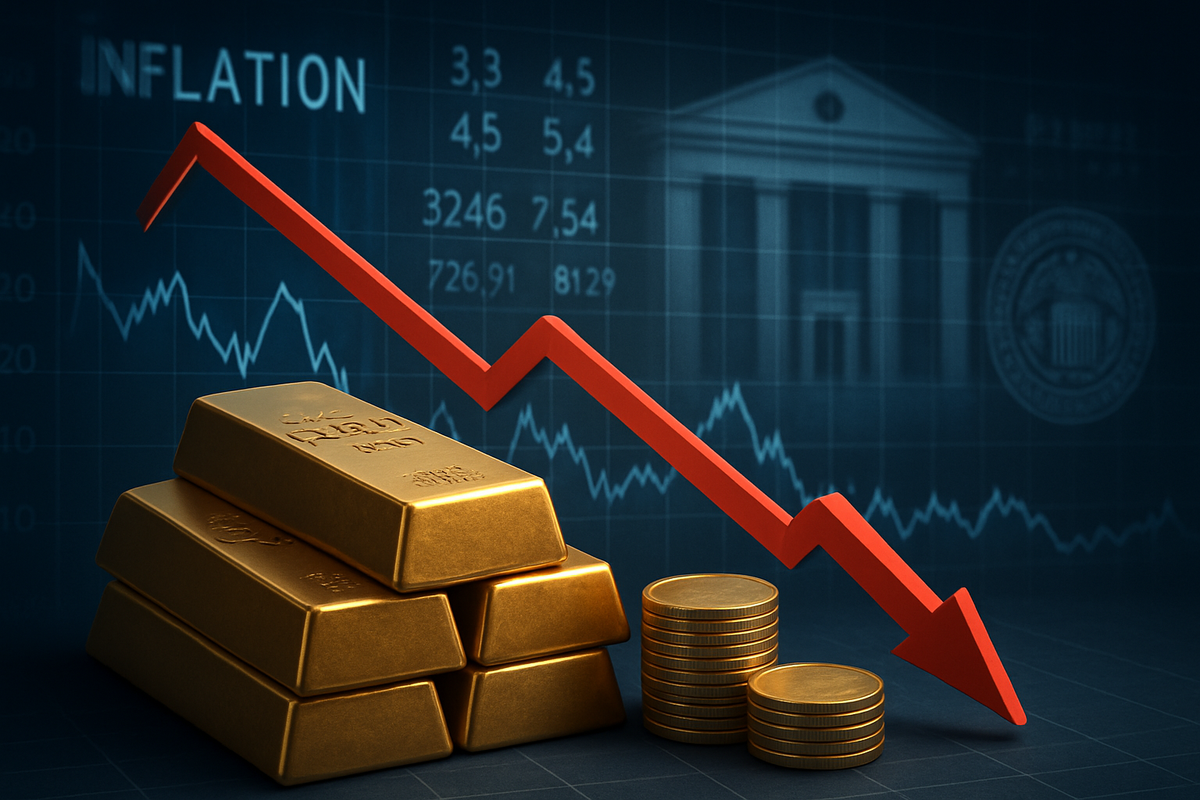
Gold, the perennial safe-haven asset, has experienced a significant price correction, with its recent dramatic fall largely attributed to widespread investor profit-booking. This strategic retreat comes as market participants brace for the release of critical US inflation data and anticipate upcoming Federal Reserve policy decisions, which are poised to dictate the near-term trajectory of the precious metal and broader financial markets. The sudden decline underscores the market's heightened sensitivity to economic indicators and monetary policy, highlighting a period of cautious optimism and strategic repositioning among investors.
The precious metal witnessed a dramatic "flash crash" on October 21, 2025, with spot gold plummeting over 5% in a single trading session – its steepest daily drop in over a decade. Prices fell from a recent record high of $4,381.21 per ounce to around $4,106.46-$4,130 per ounce, continuing to retreat further on October 22, 2025, to levels around $4,067.31 per ounce. This sharp correction follows an extraordinary year-long rally, during which gold surged by an estimated 54-60% year-to-date, pushing technical indicators into "overbought" territory and making it ripe for a correction. Both professional and retail investors capitalized on these substantial gains, leading to a cascade of sell orders that overwhelmed buyers and accelerated the decline. Beyond profit-taking, a strengthening US dollar, easing geopolitical tensions, and rising Treasury yields also contributed to the downturn, as investors sought higher returns in other asset classes and demand for safe-haven assets lessened.
Economic Indicators Set the Stage for Gold's Volatility
The market's current focus is squarely on the impending release of the September US Consumer Price Index (CPI) report, which was delayed due to a government shutdown. Forecasts suggest an increase in annual US inflation from 2.7% to 2.9%, potentially marking the highest reading in four months, while core CPI is expected to remain steady at 3.3% year-over-year. A stronger-than-expected inflation report would likely bolster the US dollar and could negatively impact gold prices in the short term, as it might lead the Federal Reserve to reconsider or delay anticipated interest rate cuts. Conversely, a weaker inflation reading could put selling pressure on the US dollar, typically boosting gold prices by making the dollar-denominated metal more affordable for international buyers.
Adding to the anticipation, the Federal Reserve's upcoming policy meeting next week is widely expected to result in a 25-basis-point interest rate cut, with further anticipation of two additional cuts by year-end. Lower interest rates generally create a more favorable environment for gold, as they reduce the opportunity cost of holding the non-yielding asset compared to interest-bearing alternatives. Additionally, rate cuts often weaken the US dollar, further enhancing gold's attractiveness. However, the relationship is complex; while higher rates can make dollar-denominated assets more appealing, factors such as geopolitical tensions and the broader direction of monetary policy can also significantly influence gold's performance. The conclusion of the peak gold buying season in India also played a minor role in softening physical demand.
Public Companies Brace for Impact
The fluctuating price of gold directly impacts companies involved in its extraction, refining, and trading. Gold mining giants like Barrick Gold (NYSE: GOLD) and Newmont (NYSE: NEM) are particularly sensitive to price movements. A sustained fall in gold prices could compress their profit margins, reduce exploration budgets, and potentially lead to asset write-downs. Conversely, a rebound in prices would significantly boost their revenues and stock performance. Investors holding shares in precious metals exchange-traded funds (ETFs) such as the SPDR Gold Shares (NYSEARCA: GLD) or the iShares Gold Trust (NYSEARCA: IAU) are also directly exposed to these price swings, experiencing immediate gains or losses in line with gold's market value.
Beyond miners and ETFs, companies that utilize gold in their products, such as luxury jewelers or electronics manufacturers, might see slight shifts in their input costs. However, for most, the impact is less direct and more about broader economic sentiment. The overall market reaction to the upcoming economic data and Fed decisions will also influence investor confidence, which can indirectly affect a wide range of public companies across various sectors. Companies with strong balance sheets and diversified operations might be better positioned to weather price volatility compared to those heavily reliant on gold's performance.
Wider Significance and Market Trends
This recent gold price correction fits into a broader narrative of market recalibration as global economies grapple with inflation, interest rate expectations, and shifting geopolitical landscapes. Gold's role as an inflation hedge and safe haven is being tested against a backdrop of potentially normalizing interest rates and a fluctuating US dollar. The interplay between these factors creates a dynamic environment where gold's value is constantly re-evaluated. Historically, gold has often served as a reliable hedge against inflation, showing strong average annual returns when US inflation exceeds 3%. However, its performance during periods of aggressive rate hikes, such as 2022-2023, also demonstrated resilience due to persistent inflation concerns and geopolitical uncertainties, indicating that multiple factors are always at play.
Potential ripple effects include shifts in investor capital from precious metals to other asset classes, such as equities or bonds, if risk sentiment improves or interest rates become more attractive. Regulatory bodies will closely monitor market stability, particularly in derivatives markets where gold is heavily traded. The event also highlights the increasing interconnectedness of global financial markets, where a shift in US economic policy or data can have immediate and significant repercussions worldwide. This correction serves as a reminder of the inherent volatility in commodity markets, even for assets traditionally seen as stable, and underscores the importance of a diversified investment strategy.
What Comes Next: Navigating the Uncertainty
In the short term, gold's trajectory will be heavily influenced by the September US CPI report and the Federal Reserve's upcoming policy statement. A higher-than-expected inflation figure or a more hawkish stance from the Fed could lead to further downward pressure on gold, while softer inflation or a clear commitment to rate cuts could provide a much-needed boost. Investors will be keenly watching for any signals regarding the pace and extent of future rate adjustments.
Longer-term possibilities for gold remain generally positive, despite the recent correction. Many analysts view this downturn as a technical adjustment within a broader uptrend. Persistent inflation concerns, ongoing central bank gold buying, and lingering geopolitical risks are expected to provide underlying support for gold prices. Potential scenarios include a stabilization around the $4,000 per ounce mark in the near term, with major banks forecasting higher targets in 2026 and beyond. Strategic pivots for investors might involve re-evaluating their exposure to gold, potentially using any further dips as buying opportunities, or diversifying into other inflation-hedging assets. Market opportunities could emerge for those who can accurately predict the Fed's next moves and the direction of inflation.
Wrap-Up: A Market in Flux
The recent fall in gold prices, driven by investor profit-booking in anticipation of crucial US inflation data and Federal Reserve policy decisions, serves as a significant market event. It underscores the profound influence of macroeconomic indicators and monetary policy on commodity valuations. While the "flash crash" was dramatic, many experts view it as a technical correction within a larger bullish trend, rather than a fundamental shift. The market is currently in a state of flux, with participants carefully weighing the potential implications of upcoming economic announcements.
Moving forward, investors should closely monitor the US CPI report for September and the Federal Reserve's interest rate decision. These events will provide crucial insights into the Fed's commitment to monetary easing and the trajectory of inflation, both of which are paramount for gold's performance. The resilience of gold in the face of various economic headwinds and its historical role as a store of value suggest that while volatility may persist in the coming months, its long-term appeal as an inflation hedge and safe haven is likely to endure. Strategic patience and a keen eye on economic fundamentals will be essential for navigating the gold market in the months ahead.
This content is intended for informational purposes only and is not financial advice


















